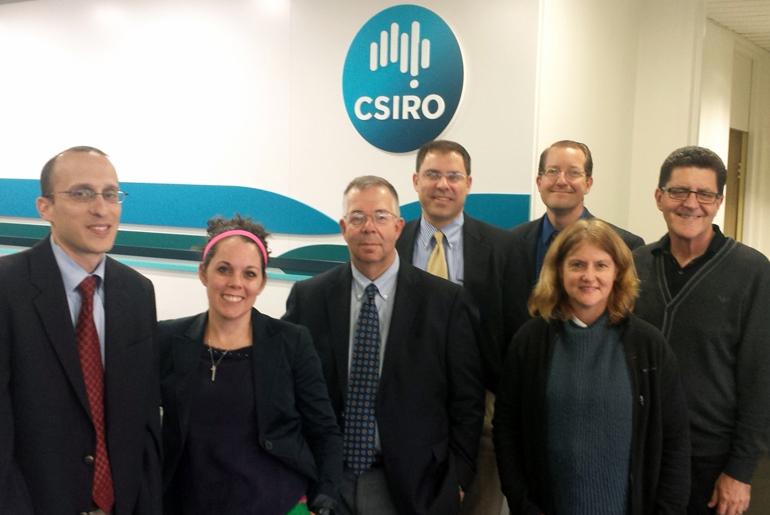
In May, researchers with the Texas A&M Engineering Experiment Station’s Texas Center for Applied Technology (TCAT) attended a knowledge exchange workshop for the new Multi-Laboratory International Collaboration Environment (MICE) project. The workshop was held by the Institute for Infectious Animal Diseases (IIAD), a Department of Homeland Security Science and Technology Directorate (S&T) Center of Excellence headquartered at Texas A&M University and the Commonwealth Scientific and Industrial Research Organisation (CSIRO), Australia’s federal government agency for scientific research. The workshop was held over several days at three different CSIRO locations: Sydney, Canberra and Geelong.
Funded by the S&T Chemical and Biological Defense Division, the two-year MICE project aims to investigate, implement, pilot and evaluate a virtual collaborative environment that will support bringing together animal health diagnostic and research biocontainment laboratories.
“Rapid, collaborative communication is a key element to containing or controlling the outbreak of high-consequence livestock diseases,” said Dr. Michelle Colby, chief of S&T’s Agriculture Defense Branch. “This project is designed to enhance collaboration and coordination among international experts, researchers and responders in support of day-to-day operations as well as during an emerging outbreak.”
The project will enable and improve the abilities to facilitate meetings, research discussions, data analyses, training events and formal briefings between researchers and responders. Ultimately, the program will assess different commercial and non-commercial solutions for virtual collaboration and develop and execute an implementation strategy for integrating this technology with other functionality within AgConnect®. The critical final phases of the project will include fielding the system to several diagnostic and biocontainment laboratories in the U.S. for evaluation.
On the first day of the workshop the group reviewed TCAT’s Disaster Relief and Emergency Medical Services (DREAMS) and mLife medical platforms. DREAMS is an emergency platform designed to expedite access to medical expertise by transmitting video and physiological telemetry to a remote physician. The system enables the physician’s medical expertise to be extended to the patient by increasing the level of situational awareness of the physician so lifesaving decisions can be made remotely in many cases. The mLife platform incorporates technology from the DREAMS project with the focus on creating a research testbed for investigating this technology as a means to establishing a new paradigm in mobile healthcare.
“MICE has many similarities with the DREAMS and mLife medical platforms in that collaboration among experts who are widely dispersed can be made highly effective,” said Dr. Jim Wall, executive director of TCAT. “It is possible if all participants are connected by technology to share a common understanding or gain a level of situational awareness elevated to a degree high enough to support either decisions or research inputs being sought from experts who are not physically present.”
The group also met with the CSIRO team and reviewed the CSIRO Collaboration Platform (CCP) prototype, IIAD’s AgConnect® suite of tools, and the MICE program. The group then traveled to the Australian Animal Health Laboratory in Geelong, Victoria, for the second day’s workshop, where TCAT and IIAD staff members were able to see the CCP in action, learn more about its capabilities, strengths, weaknesses, modes of use and the challenges encountered during development, deployment and use.
An initial discussion also identified some of the international operational requirements and uses for the system. The third day’s workshop was in Canberra, Australian Capital Territory, with CSIRO’s Information Management and Technology group. The workshop discussed some of the security requirements to assure future interoperability with CSIRO facilities. The last day’s workshop was held again at Marsfield to plan and discuss the next steps of the project. Attending the meeting from and TCAT and IIAD were: Dr. Jim Wall, TCAT executive director; Dr. Keith Biggers, TCAT director of computing information and technology; Christopher Kocmoud, TCAT senior engineer; Dr. Melissa Berquist, IIAD associate director; and Dr. Matthew Cochran, IIAD program director.
Photo (left to right): Biggers; Berquist; Wall; Cochran; Kocmoud; Nerolie Oakes, Data 61 senior engineer; and Dr. John Zic, Data 61 research group leader.
